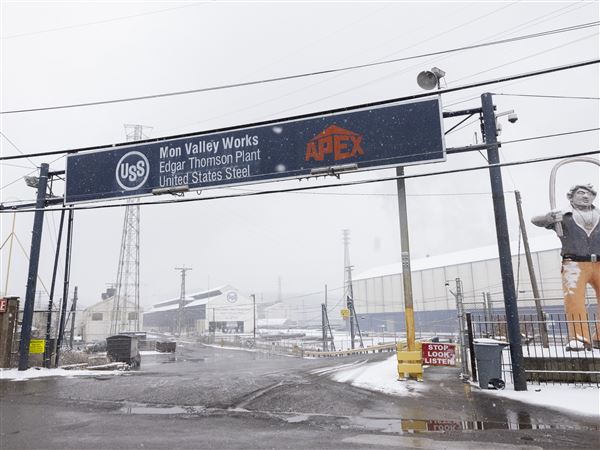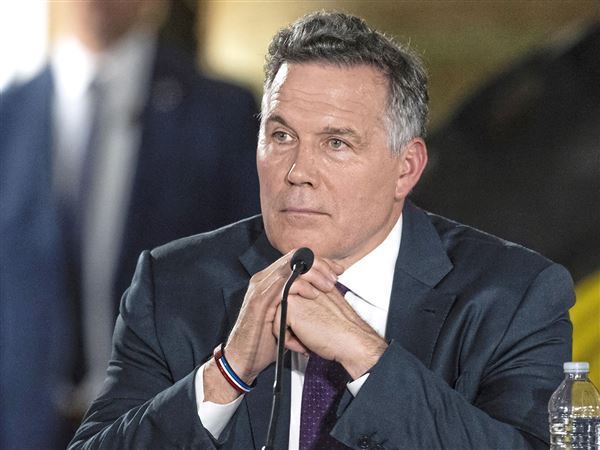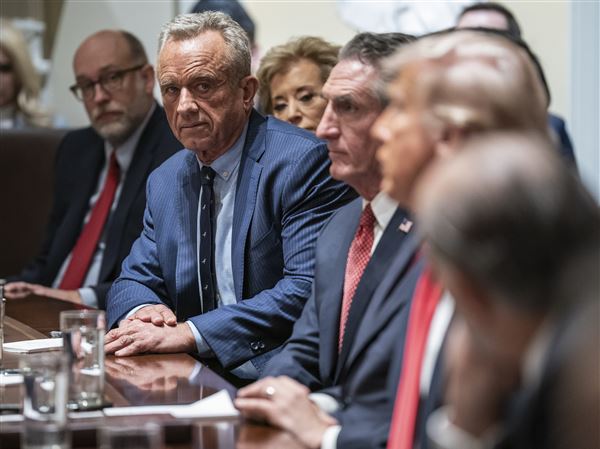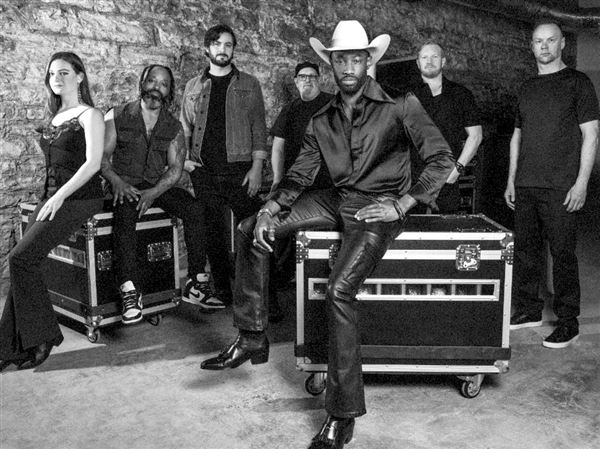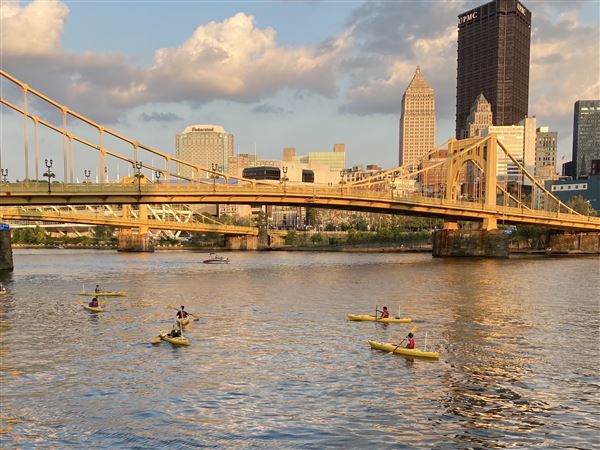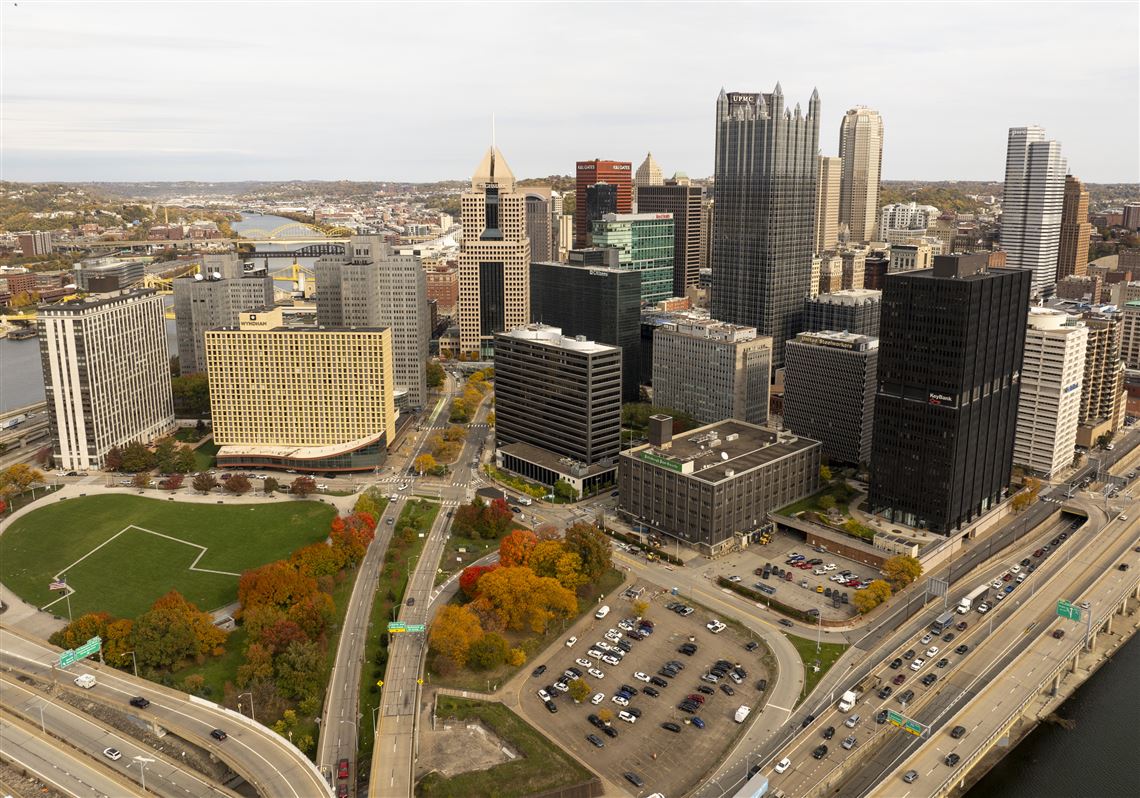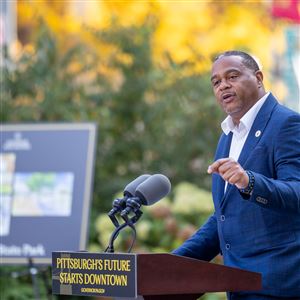The nearly $600 million plan to revitalize Downtown Pittsburgh started with breakfast.
Over the course of nearly a year, some of the city’s most powerful corporate and civic leaders met over pancakes and eggs at Kelly O’s in the Strip District to hash out ways to revive an area staggered by half empty office buildings, concerns about crime and cleanliness, and plummeting property values.
Some of the breakfasts — and a few lunches — involved one-on-one meetings. Others were in groups. But they all were aimed at developing a single menu — a plan to rescue the Golden Triangle.
“The idea was to figure out what we had in common and where we saw the opportunities,” said David L. Holmberg, board chair of the Allegheny Conference on Community Development and president and CEO of Highmark Health.
Those early bird specials culminated Friday in perhaps the most sweeping urban undertaking since the city’s first renaissance in the 1950s, when the focus was on cleaning up the water, the air and the sky, and which led to the development of Point State Park and Gateway Center.
The latest blueprint for rescuing Downtown will represent a clean-up of a different sort.
It will involve office-to-residential conversions; makeovers for Market Square, Point State Park, and a four-acre stretch of Eighth Street in the Cultural District; and initiatives to address issues such as mental illness and drug addiction, safety, cleanliness and business recruitment.
Gov. Josh Shapiro has committed $62.6 million in state funding to the effort. A who’s who of corporations and foundations, along with the city’s three major professional sports teams, have committed more than $40 million. And the city’s Urban Redevelopment Authority is contributing another $22.1 million.
Those contributions are expected to spur $376.9 million in private investment, much of it coming from building conversions, including a $200 million plan to turn the historic 44-story Gulf Tower into 225 apartments and a 126-room luxury hotel.
In announcing the ambitious 10-year plan Friday, Mr. Shapiro at several points emphasized the teamwork involved in bringing it to this point.
He mentioned the importance of commitments from about 20 corporations, businesses, foundations, and the sports teams.
They included the likes of Highmark, PNC, BNY, Dollar Bank, Duquesne Light, Pitt Ohio, Federated Hermes, First National Bank, Giant Eagle, PPG and Reed Smith. Foundations involved were Buhl, Eden Hall, the Heinz Endowments, Hillman and Jewish Healthcare.
“Everyone has understood the importance of having some skin in the game,” he said.
As office woes and concerns about crime mounted, the governor noted that he was worried about the state of Pittsburgh’s Downtown when he took office in January 2023.
But even so, he stressed to all of the stakeholders involved that he would not commit state money to any redevelopment effort unless everyone was “rowing in the same direction.”
“We all had to agree on what the projects were. We all had to agree on the vision. We all had to agree on the funding. We all had to have some skin in the game here. And once we were all clearly rowing in the same direction, we said, let’s go,” he said.
That’s where the breakfasts came in.
Mr. Holmberg said the goal was to understand what was important to various stakeholders — corporations, the foundations, and the city and the county — and what they viewed as priorities for remaking Downtown.
“There was a lot of time spent literally at Kelly O’s having one-on-one breakfasts with people trying to align,” he said. “We all know we’re in an environment right now where there are so many issues and so much noise, and what you have to do is figure out what those three or four things are that everybody agrees upon.”
It also involved a lot of “trust building” among the various private and public entities with a stake in the outcome.
“Today we’re seeing that come together. We’ve built trust that we would all be there and show up and that we could take action in a coordinated way,” Mr. Holmberg said.
While the Allegheny Conference was one of the leads in the effort, it was not the only one. Mr. Holmberg said PNC and Bill Demchak, its CEO, also was heavily involved in the initiatives. Others included the leaders of Dollar Bank and Federated.
‘A whole new world’
The revitalization plan is taking shape nearly two years after the Pittsburgh Post-Gazette reported about a private meeting in which business owners and merchants expressed alarm over shooting, fights, drug dealing and panhandling in Downtown — and demanded more action from Mayor Ed Gainey.
It comes after a year in which Golden Triangle building owners have won about half a billion dollars in property assessment reductions because of high office vacancies and a change in the ratio used to calculate taxable value. Three Downtown properties also have been subject to foreclosure actions.
Mr. Holmberg said the plan to help right some of the ills has taken time to develop. He said various stakeholders have been at work behind the scenes for some time trying to build the consensus for change.
At the same time, he acknowledged that “it’s not perfect, it’s not all inclusive, it leaves a lot of room for more.”
The plan, for example, does not address Smithfield Street as a whole, a stretch that has been plagued by concerns about safety, open drug use, lewd behavior, and homelessness.
In fact, Weiner World, a longtime Smithfield Street staple, moved to U.S. Steel Tower earlier this year because of such concerns. Another business, Fragasso Financial Advisors, relocated to Sewickley.
While Mr. Holmberg said he believes the street has improved, he added that it continues to be a priority for redevelopment. But he pointed out that there are many factors that go into that, including the need for site control.
“It’s going to take not only focus but more of a concentrated effort,” he said.
One local official who has been involved in Downtown redevelopment in the past is excited about the plan.
Brian Walker, president of the NAI Burns Scalo real estate firm, is chair of the board of directors for NAIOP, a commercial real estate development association. He has visited 27 other cities over the past six months.
He said Pittsburgh had been lagging behind many of them in terms of revitalization. But the plan unveiled Friday now moves the Steel City “to the top of the list.”
“It’s massive. It’s on a large scale, way bigger than what I’ve seen in my travels,” he said.
Mr. Walker, who worked for Piatt Companies when it was turning old department stores and office buildings Downtown into mixed use and residential developments, said the key to the new plan is the state investment in the office-to-residential conversions.
He said such projects need that kind of help to make them work financially.
“This announcement to help adjust that so that we can actually convert these floors to alternative use is exactly what I’ve been preaching on the national level for three years now, and it’s major,” he said.
Overall, the nearly $600 million plan “will launch us into a whole new world. It’s absolutely critical,” Mr. Walker said. “Honestly and truthfully, I’ve seen other parts of the country doing this sooner but not to this magnitude, not with the leadership that’s stepping up to do this massive investment in a city.”
Beside Gulf Tower, other buildings slated for conversion include the former YWCA on Wood Street, the former Federal Home Loan Bank building on Grant Street, 933 Penn Avenue, and buildings at First Avenue and Market Street and Smithfield Street and Fort Pitt Boulevard.
According to the state, the building conversions will create or preserve almost 1,000 residential units, with nearly one third designated as affordable for residents with low to moderate incomes.
Other elements of the plan include improvements to Point State Park, Market Square, and the Eighth Street block of the Cultural District. There’s also money for two additional police officers to patrol Downtown, support services for people suffering from mental illness and drug addiction, and a team dedicated to helping to address youth violence.
Beyond the $62.6 million in direct funding, state commitments include $48.3 million in low income tax credits, $11.9 million in Pennsylvania Housing Finance Agency loans, and $166,500 in state tax credits.
A matter of survival
The plan has already won the backing of some Downtown retailers and restaurant owners.
Jordan Nicholas, owner of Nicholas Coffee & Tea Company in Market Square, said he believes the projects will spur even more development as people see progress.
"How could you not be in favor of it? It’s great that you have a public-private partnership working together to address an issue in the city and do what you can to create a more welcoming city,” he said.
"You have to make up for the loss of office workers that aren't in town anymore. Clearly, this conversion project will help address that issue and create more of a neighborhood feel — we’re a neighborhood coffee shop."
Nicky Geanopulos, owner of Nicky’s Cafe in the Grant Building, said the kind of office conversions and projects envisioned under the plan are needed “in order to survive.”
"If there’s no faces, no people — you’re not able to feed anyone because they’re not even here. If we have no people, you can’t feed them, so we don’t even have an opportunity to get them,” he said.
"I’m here in the great Grant Building. It's a traditional tower. A lot of our lawyers are based here, and judicial offices, so we still have the interaction, but unfortunately, all the towers are suffering in Downtown because of the three-day work week and people working from home."
He stressed that work proposed under the plan needs to happen now.
“It can’t take 10 years,” he said.
In announcing the initiatives Friday, Mr. Shapiro stressed that all of the conversion projects are shovel ready and should be completed by the end of 2028. The money the state is investing “will not sit on some developer’s balance sheet,” he vowed.
On Smithfield Street, Jack Cohen, owner of S.W. Randall Toyes and Giftes, which has been at the location since 1978, remembers when the sidewalks teemed with people.
"We moved down here because you couldn't even cross the sidewalks at lunchtime, there were so many people. A lot has changed. Anything would be an improvement — anything. So we'll see what happens, I guess. We've got nothing to lose.”
City Councilwoman Theresa Kail-Smith took a more measured view.
"I'm always supportive of doing what we need to to have a strong core, but I'm also concerned about what's happening in our residential areas and how we're addressing the blight in those neighborhoods,” she said.
Andrew Masich, president and CEO of the Sen. John Heinz History Center in the Strip, said the 10-year plan, if successful, could mark another city renaissance.
Pittsburgh previously reimagined its Downtown twice, during periods of major investments known as Renaissance One and Renaissance Two. The first, in the 1950s-60s, was focused on cleaning up the city's land, air and water; on knocking down substandard structures and building new facilities, including the Civic Arena. The second, in the 1970s-80s, focused on investment in high-rises and cultural attractions.
As for this wave of investment, Mr. Masich said: “It’s a way of reimagining Downtown, once again, in response to changing demographics and economics — the same reasons that the previous renaissances occurred.”
Mr. Holmberg, for one, said he believes it will be a game changer.
“This is team ball,” he said. “But let’s be clear: We’re on offense now. We’re not on defense anymore.”
Staff Writer Hallie Lauer contributed to this story
First Published: October 27, 2024, 9:30 a.m.
Updated: October 28, 2024, 7:25 p.m.
